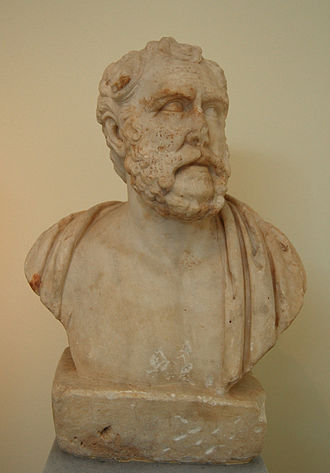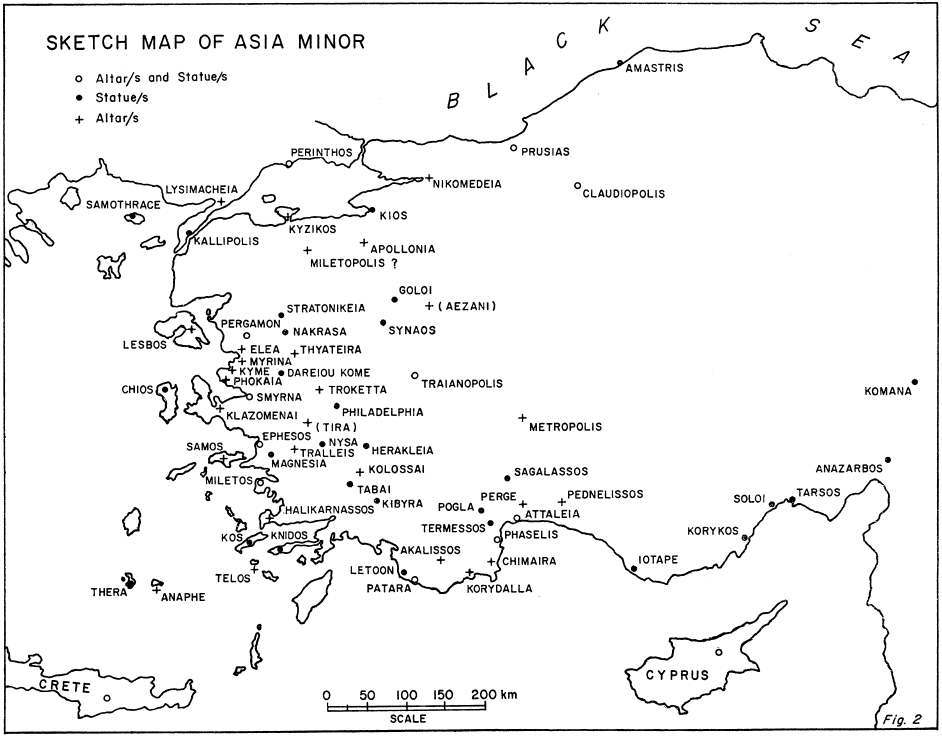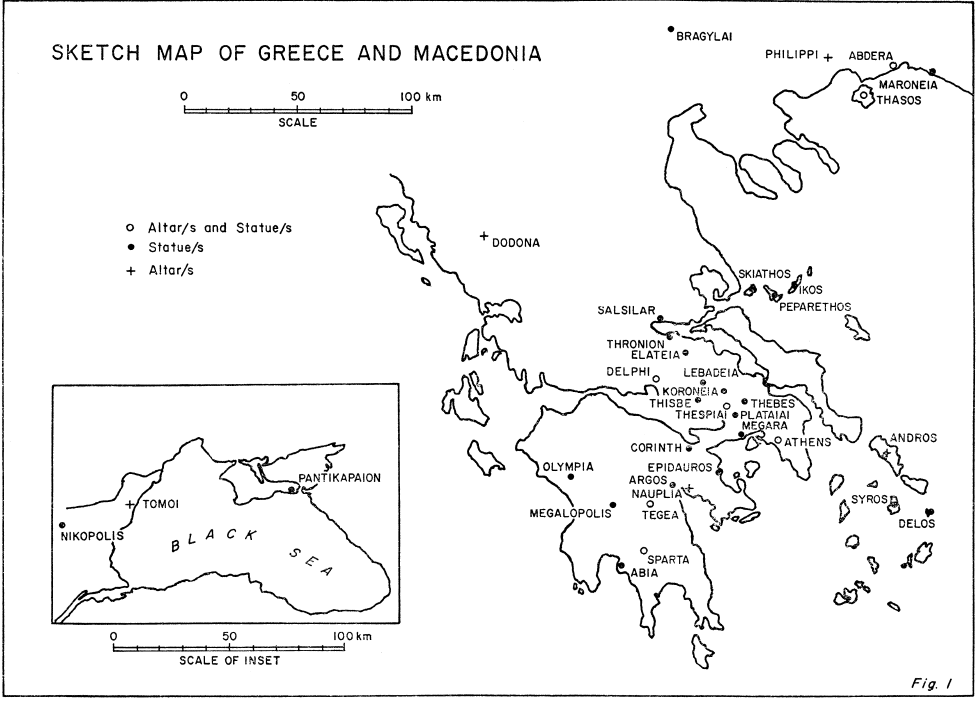
Revelation 13:11 And I beheld another beast coming up out of the earth; and he had two horns like a lamb, and he spake as a dragon.
Thomas Witulski identifies this other beast that arises from the earth with the sophist Antonius Polemon. We introduced him in the post on emperor worship and Revelation. We know about him today from his own writings, from his ancient biographer Philostratus and from various inscriptions in Smyrna and Pergamon. Polemon was the descendant of the last king of Pontus, Polemon II. He trained as a sophist and rhetorician in Smyrna, became a diplomatic envoy on behalf of Smyrna in Rome, taught rhetoric himself and sometimes acted as a court orator. His school for rhetoric attracted some fame for his city and youth from Asia, Europe and the islands crowded Smyrna to learn from him. He was made a guardian of temples and a priest of Bacchus (Dionysus) and made head of the running of the games in honour of “Hadrian Olympus”. He accompanied Hadrian on his journeys through Asia and appears to have acted as a highly valued and influential advisor to the emperor.
Revelation 13:12 It exercised all the authority of the first beast on its behalf, and made the earth and its inhabitants worship the first beast, whose fatal wound had been healed.
The author of the apocalypse introduces him as a speaker in the service of the first beast. The classicist G. W. Bowersock wrote of Polemon’s renown:
Hadrian, another admirer of Polemo, extended that privilege [of free travel wherever he wished] to the sophist’s posterity and added others; his great-grandson, Hermocrates, is found fully equipped with privileges of all sorts. Hadrian’s relations with Polemo are well illustrated by the emperor’s own admission that his final statement on the affairs of the whole empire (a breviarium totius imperii, one supposes) was prepared with Polemo’s advice. Nor is this the only indication of Hadrian’s regard: his invitation to that sophist to deliver the oration at the consecration of the Olympieum at Athens was perhaps an embarrassing repudiation of the obvious person for the occasion, Herodes Atticus. Polemo’s enemies at Smyrna had once tried to compromise him by allegations that he was spending on himself funds transmitted by the emperor for the good of the city, but Hadrian replied firmly with a letter declaring that Polemo had rendered him an account of the moneys which he had given the city. Not that the great sophist did not spend extravagantly for his own ostentation. He could be seen travelling along the roads of Asia in a chariot with silver bridles and an elaborate entourage of pack-animals, horses, slaves, and dogs. But Philostratus rightly observed that such a display gave lustre to a city no less than a fine agora or a splendid array of buildings, ‘for not only does a city give a man renown, but a city itself acquires it from a man’. (Bowersock, 48)
Witulski writes in Die Johannesoffenbarung Und Kaiser Hadrian, p. 228,
Moreover, it is quite likely that Polemon, in his festive speech on the occasion of the consecration of the sanctuary of the Zeus Olympus in Athens, to some extent as a replica of Hadrian’s favour, possibly also previously coordinated with the latter, called for altars dedicated to Hadrian Olympus to be erected in private homes in the cities and areas around the Aegean. Numerous evidences can be cited for these altars in the provinces of Achaea, Macedonia, Thracia, and especially Asia. (my own machine assisted translations of all Witulski quotes)
In Kaiserkult in Kleinasien, Witulski explained in a little more detail the reason for concluding that household altars were ordered in association with the occasion of the inauguration of the Athenian temple to Zeus Olympus: pp. 130ff
With reason, it is to be noted that the consecration of the Athenian sanctuary of Zeus Olympus and the associated foundation of the institution of the Panhellenion also led to altars524 being erected in private houses525 to the reigning emperor Hadrian in the Greek-influenced east of the imperium Romanum. The geographical focus of the erection of these altars was obviously in the Greek motherland and in the western Asia Minor, i.e. in the Roman province of Asia.526 It is remarkable that the inscriptions carved on each of these altars have essentially the same wording: The reigning emperor Hadrian is given the title ‘Ολύμπιος [=Olympos] and worshipped as σωτήρ καί κτίστης [=Saviour Founder]. The regularity of the form of the altar inscriptions, expressed in the parallelism of wording and phrasing, and the large number of altars erected “imply the official nature of the occasion on which the altars were dedicated to Hadrian Olympios, Savior, and Founder“. In view of the Ολύμπιος title attached to Hadrian in these inscriptions, it is difficult to deny a connection between the content of the corresponding altars and the statues of the emperor erected in the temenos of the Athenian sanctuary of the Ζευς ‘Ολύμπιος, on the bases of which the Όλύμπιος title is also found within the imperial titulature. Therefore, the occasion that led to the erection of the house altars dedicated to Hadrian can be assumed to be the consecration of the Ζεύς Όλύμπιος sanctuary in Athens or an event closely related to this consecration, such as the founding of the institution of the Πανελλήνιον [=Panhellenion].
Anna Benjamin in 1963 documented as many as 269 altars to Hadrian in Greece-Asia so no doubt that number has increased since. The maps below identifying the sites where these altars have been found are copied from Benjamin’s article:
It is worth going beyond Witulski’s own words and reading what Benjamin herself had to say about the worship of Hadrian in this region (pp 58-60):
It was in the year 131/2 that Hadrian’s Panhellenic program reached its climax at the final dedication of the Olympieion [the Temple to Zeus in Athens] and the foundation of the Panhellenion. At the Olympieion, cities from all over the Greek world dedicated statues of Hadrian Olympios [i.e., the title of Zeus]. The passage in Pausanias (I, 18, 6) describing the host of Hadrian statues has given rise to much speculation, but as it stands, seems to imply the existence of bronze statues . . . as well as statues of Hadrian around the peribolos which were outdone by the colossal statue erected by the Athenians. . . .
A glance at the list below of altars to Hadrian reveals that the most widely spread and popular epithet assumed by Hadrian was Olympios (sometimes Hadrian is Zeus Olympios) and not Panhellenios. . . .
. . . . a great number of altars were dedicated in Athens to Hadrian Olympios, Savior, and Founder . . . .
Given Polemon’s position in relation to Hadrian and the authority he held it is impossible to think, Witulksi suggests, that the orator was not central to ordering the setting up of these altars, cities being required to donate statues of Hadrian to Athens in addition to their own statues, as well as obligation of all homes to incorporate altars to the emperor-god.
The household shrines remind me of my visits to Buddhist areas in Asia where one finds shrines not only at the entrances of houses but also inside any house or business one enters.
As a (False-) Prophet
The temple Olympian Zeus Athens had been completed at last after an interval of five hundred and sixty years, and when the Emperor consecrated it as a marvellous triumph of time, he invited Polemo also to make an oration at the sacrifice. He fixed his gaze, as was his custom, on the thoughts that were already taking their place in his mind, and then flung himself into his speech, and delivered a long and admirable discourse from the base of the temple. As the prooemium of his speech he declared that not without a divine impulse was he inspired to speak on that theme. (Philostratus, Lives of the Sophists)
It is hard to doubt that Polemon on that occasion when he declared that his speech was divinely inspired, reminded his audience that their emperor Hadrian was “soter” and “ktisos” [saviour and founder/guardian], a universal saviour worthy of worship and that all inhabitants should demonstrate their loyalty and devotion to him with their private shrines.
Polemon claimed to be able to foretell what people would do through his skills as a physiognomist. There is even on record an episode in which he warned Hadrian of an assassination plot by a certain individual. Polemon thus “saved” the emperor’s life by having the suspect apprehended before he could act. It was through reading the signs on his face and body that Polemon claimed to know the intent of the would-be assassin. One scholar described the manual Polemon wrote on this subject:
For Polemo, the second-century Sophist from Asia Minor, who wrote the most influential of these works, physiognomical theory served as a classificaory grid to contain his political and intellectual opponents. In a sense it was a sophisticated development of the magical use of invective in the tabellae defixionum, or curse tablets. The appreciation of the magical power of rhetoric appears as a theme at least as early as the fifth century B.C. It is a leitmotif in Platonic discussions of rhetoric, where rhetoricians are often confuted as conjurers. Plutarch’s Life of Pericles contains an early expression of this power: Thucydides Melesiou, when asked by King Archidamus whether he or Pericles was the better wrestler, replied that, whenever he threw him, Pericles would persuade everyone that he had not been thrown. Magnus the iatrosophist was associated with similar powers: he would win medical competitions by persuading the audience that his opponent’s patients were still ill, even as they were thanking their doctors for having cured them. Sophists of the Second Sophistic, the most successful rhetoricians, such as Dionysius of Miletus, Hadrian of Tyre, and Apuleius were associated with sorcery. But Polemo created a new magic of old elements, a new ψυχαγωγία (winning of souls). Rather than actually making wax images of his opponents to bum, with physiognomics he constructed their bodies so as to destroy their characters. And destroying the … moral persona of a rival deprived him of the moral claim to persuade.
In an extended systematization of the common understanding of the physique as a collection of signs of the character, Polemo evolved a treasury of condensed meaning for rhetorical use. It was technically persuasive because of the form of systematization he used. Thus, it was methodologically in line with contemporary intellectual style, conforming to the model of the [techne] as we have seen it in astrological writing. . . . Physiognomies shared concerns with oneiromancy: both drew on the treasury of learning about animals, for instance. Physiognomists also drew on some of the learning common to geographical, astrological, and medical writing, in particular the ideas about the influence of the stars and the climate on physical and character types of different races. . . . (Barton, 96f)
Another contemporary of Hadrian was Aspanasias who bracketed prophets, sophists and magicians as sharing the same vices:
. . . although previously those who pretended to prophecy, or to wisdom the way the sophists pretended to it, were called boasters, and, in general, magicians bore this name.
Recall, too, from an earlier post that we noted how “priestly juggleries” included making statues talk and move. Nor will I repeat here details of Polemon’s offices as a priest of Bacchus and head of temples for Hadrian.
We have also seen the propaganda function of the minting of travel commemorative coins. If we accept the possibility that Polemon was the person the author of Revelation had in mind as the “second beast” then it “is not implausible to assume that Antonius Polemon tried to enforce a regulation, at least within the province of Asia, according to which only the newly issued travel commemorative coins or other issues bearing Hadrian’s imprint were to be used for payment in purchases and sales.” (Die Johannesoffenbarung, p. 235)
I am well aware that a post like this is likely to raise more questions than it answers, so more to come.
Benjamin, Anna S. “The Altars of Hadrian in Athens and Hadrian’s Panhellenic Program.” Hesperia 32, no. 1 (January 1963): 57-86. https://doi.org/10.2307/147351.
Barton, Tamsyn S. Power and Knowledge: Astrology, Physiognomics, and Medicine Under the Roman Empire. Ann Arbor, Mich: University of Michigan Press, 1994.
Witulski, Thomas. Die Johannesoffenbarung Und Kaiser Hadrian: Studien Zur Datierung Der Neutestamentlichen Apokalypse. Göttingen: Vandenhoeck & Ruprecht, 2007.
———. Kaiserkult in Kleinasien : die Entwicklung der kultisch-religiösen Kaiserverehrung in der römischen Provinz Asia von Augustus bis Antoninus Pius. Göttingen : Vandenhoeck & Ruprecht ; Fribourg : Academic Press, 2007.
If you enjoyed this post, please consider donating to Vridar. Thanks!



Just to be sure I understand, does Hadrian’s name amount to 666?
I thought I had posted about that but looking through my list now I am beginning to think I somehow overlooked it. Yes, indeed, Hadrian’s name does equal the same number said to be the number of a man: it is equivalent numerically to Nero, and Hadrian did advertize himself as a second Nero among the Greeks. I must make up for what I seemed to have missed and will make that my next post.
Is Nero’s bacha bāzī Sporus comparable to Hadrian’s dear bottom Antinous? Once knew a dude who was rather fond of this print displaying it prominently: https://commons.wikimedia.org/wiki/Publius_Aelius_Traianus_Hadrianus#/media/File:%C3%89douard-Henri_Avril_(18)_Hadrian_and_Antinous_in_Egypt.jpg having first been shown it around age ten by the priest who spent years molesting him.
Very interesting material Neil. How do the five heads dead, one is, one to come, and then #8 the beast/returned Nero work, that is how does that work with Hadrian as #8? Related question (not specific to Hadrian) is how does Revelation allude to anything in history relating to #8 if Revelation was written in the time of its #6 as it self-represents? The only solutions I have seen are either that the #6 time setting is intentional fiction on the part of the authors of Revelation (like the author of Daniel having Daniel’s prophecies set hundreds of years before the time of the Maccabean revolt), or alternatively that Revelation is a poorly edited, cobbled-together redaction from sources one of which did come from the time of #6. Is there a good interpretation of these 8 “heads” in the Hadrian as #8 idea?
You’ve caught me out, Greg. I have only quickly skimmed W’s chapter addressing Rev 17. I’ll have to dig into it seriously and get back to you.
I was curious if there was anything to connect Hadrian to Patmos.
I didn’t find anything, but there’s a remark in this book about “The Acts of John by Prochorus”, which dates John’s exile possibly as late as Hadrian.
I have not come across anything. I couldn’t comment further until I read or at least get the gist of Boxall’s thesis.
although previously those who pretended to prophecy, or to wisdom the way the sophists pretended to it, were called boasters, and, in general, magicians bore this name.
This jumped out to me with all the boasting Paul did or was accused of doing and the associations with Simon Magus.
I think the Greek word Arnion used in Revelation is a non Doric variation Karnieos and the imagery of the Second Beast having two Horns like a Lamp is Apollo Karnieos.
Apollyon from Revelation 9:11 was an ancient variation on the name Apollo. Like in Aeschylus’s play Agamemnon, where Cassandra says repeatedly. “Apollo, thou destroyer, O Apollo, Lord of fair streets, Apollyon to me.”
The Tong of The Dragon could refer to a would be Prophet or Oracle of Apollo Pythios
How would these observation fit Polemon?
They have nothing to do with Polemon. I have deleted several of your comments because they are contrary to the comments policy here. Comments that merely express disagreement with a post or have another view without addressing the arguments of the post are better expressed on your own blog or elsewhere.